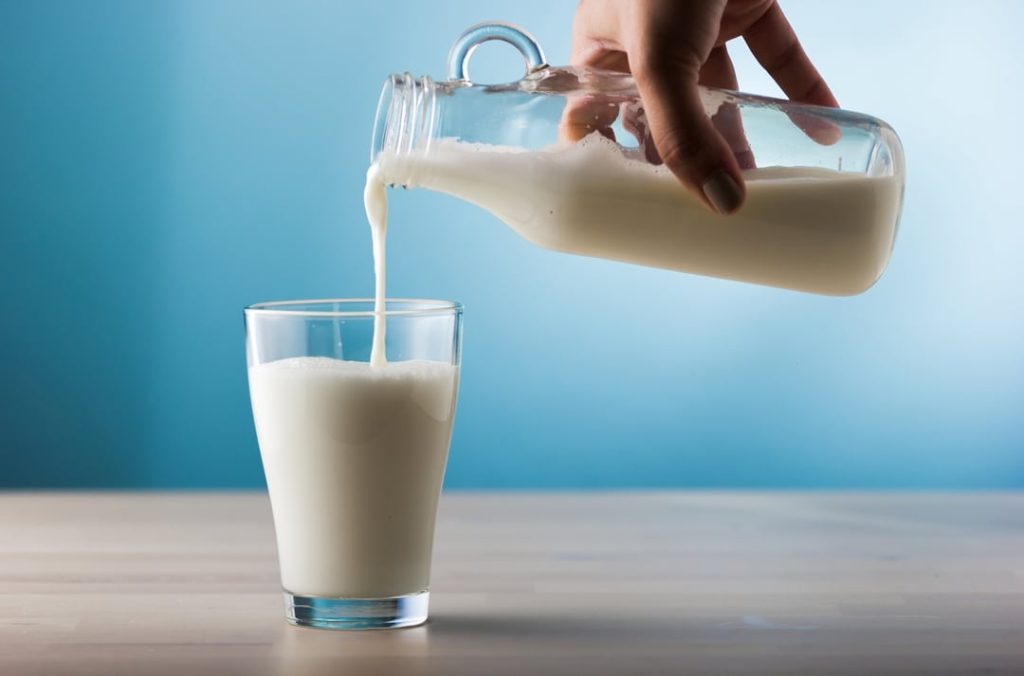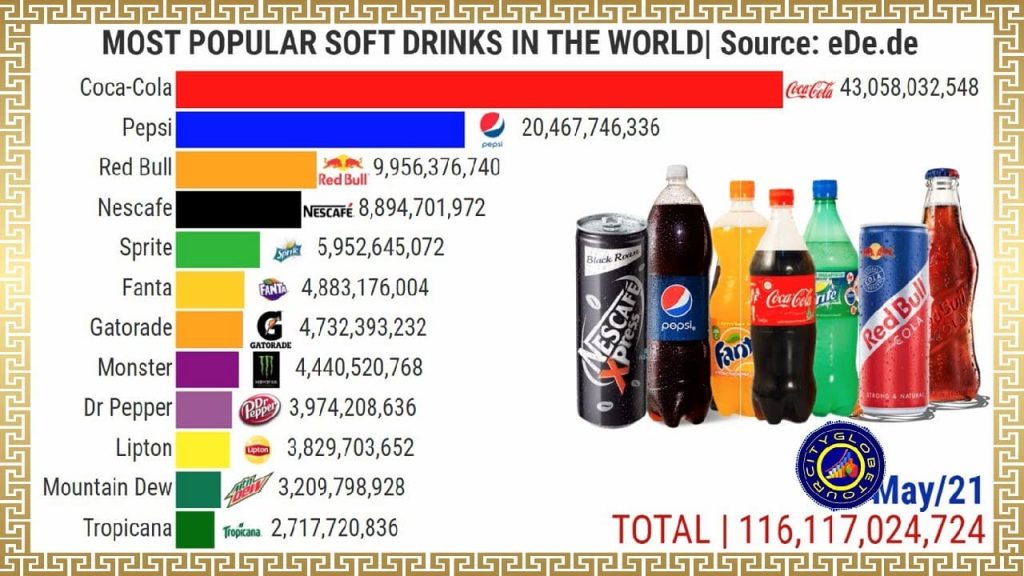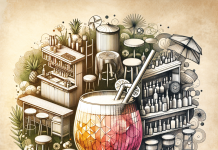Imagine taking a sip of a beverage that is loved and consumed by millions around the globe. Have you ever wondered what the most popular drinks in the world are?
From refreshing classics to iconic concoctions, this article explores the top three beverages that have won the hearts (and taste buds) of people worldwide.
So, grab your favorite drink, sit back, and join us on this delightful journey of discovering the three most popular drinks in the world!
Coffee
History and Origin
Coffee, a beloved beverage millions enjoy worldwide, has a rich and diverse history.
Its origin can be traced back to the ancient coffee forests of Ethiopia, where legend has it that a goat herder named Kaldi discovered the stimulating effects of coffee beans when he noticed his goats becoming unusually energetic after eating them.
This discovery eventually led to the cultivation and trade of coffee beans across the Arabian Peninsula and beyond.
Popular Varieties
Today, coffee comes in various popular varieties with distinct flavors and characteristics. The most commonly consumed types of coffee include Arabica, Robusta, and specialty blends. Arabica, known for its smooth and nuanced taste, accounts for most coffee worldwide.
On the other hand, Robusta, with its higher caffeine content and more robust flavor, is often used in espresso blends to add an extra kick. On the other hand, specialty blends provide unique combinations of coffee beans from different regions, showcasing the artistry and expertise of coffee roasters.
Global Consumption
Coffee is undoubtedly one of the most consumed beverages globally. According to statistics, an estimated 2.25 billion cups of coffee are consumed worldwide daily.
From early morning rituals to social gatherings, coffee has become integral to people’s daily lives. Countries like the United States, Brazil, Germany, and Japan are among the top coffee consumers, showcasing the widespread love for this delightful beverage.
Cultural Significance
Coffee holds significant cultural significance in various regions around the world. In European countries like Italy and France, coffee is deeply intertwined in social customs and enjoyed as a leisurely experience.
In the Middle East, coffee is prominent in traditional hospitality customs, with the preparation and serving of Arabic coffee considered an art form. In many other cultures, coffee is vital in bringing people together, whether for business meetings, social gatherings, or simply catching up with friends.
Health Benefits
Aside from its stimulating effects, coffee has also been found to offer a range of health benefits. Studies have suggested that moderate coffee consumption may lower the risk of certain diseases like Parkinson’s, type 2 diabetes, and liver cancer.
Additionally, coffee contains antioxidants that can help protect the body against inflammation. However, it’s important to note that individual responses to coffee can vary, so it’s best to consume it in moderation and listen to your body’s signals.
Coffee Industry
The coffee industry encompasses various stages, from cultivating coffee plants to the final beverage consumption. It is a sprawling industry that employs millions of people worldwide.
Coffee farmers, often located in regions with suitable climates, cultivate and harvest coffee cherries. These cherries are processed to remove the outer layers and reveal the coffee beans.
Once processed, the beans are roasted, ground, and packaged, ready for distribution to coffee shops, supermarkets, and other retailers. The coffee industry fuels local economies and supports countless individuals’ livelihoods along the supply chain.
Tea
Introduction to Tea
Tea is a widely consumed beverage derived from the Camellia sinensis plant. While the exact origins of tea are debated, it is believed to have originated in ancient China over 5,000 years ago.
Since then, tea has become an integral part of cultures worldwide, enjoyed for its diverse flavors and calming effects.
Different Types of Tea
The world of tea offers various options, each with unique characteristics and brewing techniques.
Common types of tea include black, green, oolong, white, and herbal tea. Black tea, known for its robust flavor, is heavily oxidized and often enjoyed with milk and sugar. Green tea, on the other hand, undergoes minimal oxidation and is lauded for its fresh, grassy taste and numerous health benefits.
Oolong tea falls between black and green tea, while white tea is the least processed and known for its delicate flavor. Herbal teas, known as tisanes, encompass caffeine-free infusions from various plants, herbs, and spices.
Tea Culture around the World
Tea culture varies significantly across different regions, offering unique rituals, traditions, and preferences. In China and Japan, tea ceremonies are steeped in history and reverence, with meticulous attention to detail in the preparation and serving of tea.
In England, afternoon tea is a cherished tradition characterized by dainty sandwiches, scones, and pots of freshly brewed tea. Chai tea is a staple in India, often enjoyed with milk, spices, and sweeteners. From the intricate tea rituals of East Asia to the cozy tea traditions of Europe, tea plays a significant role in bringing people together and fostering connection.
Health Benefits of Tea
Like coffee, tea also offers a range of health benefits. Tea is rich in antioxidants called catechins, which have been associated with a reduced risk of chronic diseases such as heart disease and certain types of cancers.
Tea contains compounds like theanine, which can promote relaxation and improve mental clarity. Green tea, in particular, is often praised for its potential to boost metabolism and aid in weight management. It’s important to note that the benefits of tea can vary depending on factors such as the type of tea, brewing methods, and overall lifestyle.
Tea Production and Trade
Tea production involves several stages, starting with cultivating tea plants in suitable regions. Tea farmers carefully tend to the plants, ensuring optimal growth and flavor development. After the leaves are harvested by hand or machine, they undergo processing methods such as withering, rolling, oxidation, and drying.
These processes vary depending on the desired type of tea, and skilled tea artisans play a vital role in maintaining the quality and authenticity of the final product. Once produced, teas are traded globally, with major tea-producing countries including China, India, Kenya, Sri Lanka, and Japan. Tea trading supports local economies, provides employment opportunities, and connects enthusiasts worldwide.
Tea Industry
The tea industry encompasses a vast network of growers, producers, distributors, and retailers contributing to the global tea market. From the small-scale tea farmers in remote regions to the multinational corporations catering to mass consumption, the tea industry is teeming with diversity.
This industry fuels economic growth and plays a vital role in preserving tea traditions, supporting sustainable farming practices, and promoting fair trade. Moreover, the tea industry offers numerous career opportunities, ranging from tea sommeliers and blenders to tea shop owners and researchers exploring the science of tea.
Water
Importance of Water
Water, a fundamental component of life, is essential for survival and well-being. It plays a vital role in numerous bodily functions, including digestion, blood circulation, temperature regulation, and waste removal. Our bodies cannot function optimally without an adequate supply of clean water, making access to safe and clean water a basic human necessity.
Water Consumption Statistics
Water consumption varies greatly depending on climate, lifestyle, and individual needs. On average, an adult human requires around 2-3 liters of water per day to maintain proper hydration.
However, this can increase in hot climates or during physical exertion. It’s important to note that water needs vary among individuals, so listening to your body and drinking water accordingly is essential.
Different Sources of Water
Water can be sourced from various natural sources such as rivers, lakes, groundwater, and the ocean. In urban areas, tap water is a common source of drinking water. Tap water goes through a treatment process to remove impurities and ensure its safety for consumption.
Bottled water, though convenient, can also be another source of drinking water. However, it’s essential to consider sustainability and environmental impacts when opting for bottled water, as the production and disposal of plastic bottles contribute to waste and pollution.
Drinking Water Safety
Ensuring the safety of drinking water is crucial to prevent waterborne illnesses and maintain public health. Governments and regulatory bodies impose strict standards and regulations to monitor water quality.
Water treatment plants employ filtration, disinfection, and testing to ensure tap water meets safety standards. It’s advisable to follow local guidelines and, if necessary, use water filtration systems or boil water in areas where water quality may be compromised.
Water Scarcity and Global Challenges
Water scarcity is a pressing global issue affecting millions of people worldwide. Rapid population growth, climate change, and unsustainable water management practices have contributed to water shortages in many regions.
Lack of access to clean water leads to various hardships, including hygiene-related illnesses, agricultural limitations, and economic constraints. Addressing water scarcity requires international cooperation, sustainable water management practices, and investments in water infrastructure to ensure the availability of this precious resource for future generations.
Sustainable Water Management
Sustainable water management is crucial to ensure the equitable distribution and conservation of water resources. This involves watershed protection, water recycling and reuse, rainwater harvesting, and efficient irrigation techniques.
Governments, organizations, and individuals all have a role in promoting sustainable water management, from implementing water conservation measures at home to supporting policies and initiatives prioritizing water sustainability on a larger scale.
In conclusion, coffee, tea, and water are three popular beverages consumed worldwide, each offering a unique taste, cultural significance, and health benefits.
Whether indulging in a freshly brewed cup of coffee, savoring the delicate flavors of tea, or staying hydrated with a glass of water, these beverages have become integral parts of our lives.
Understanding their history, production processes, and global impact allows us to appreciate and enjoy them even more.
So savor your favorite beverage and raise a toast to the diverse world of coffee, tea, and water. Cheers!











































